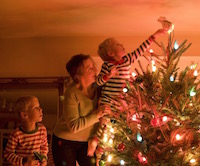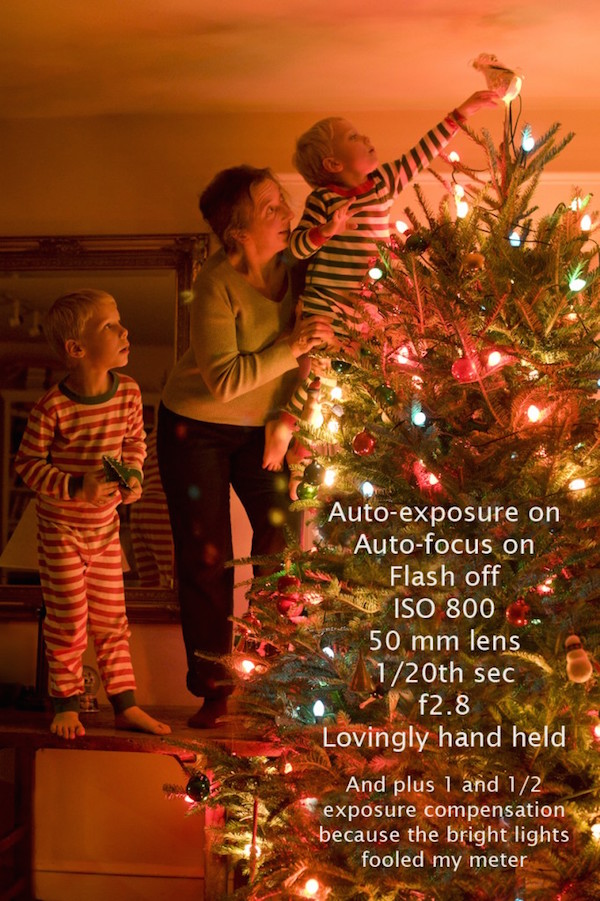Nick’s Photography Tips: How to photograph Christmas
posted Monday, December 22, 2014 at 10:50 AM EST

After wedding photographs and baby portraits Christmas morning photographs may rank in third place as some of the most important—and stressful photos—family photographers will ever shoot. Almost everyone wisely eliminates the stress factor at a wedding by hiring a photographer and just about every parent can produce some decent baby portraits. (Hey, if it didn’t work this time, you can always try it again after a good nap…for the baby, not you. Well, OK, you, too.)
But Christmas morning is a little different. Like a wedding it’s only going to happen once, but I’ve never heard of ANYONE hiring a photographer to come over and photograph their kids opening gifts at 6 AM on Christmas morning.
And unlike baby photography you’re only going to get one chance at watching the little angels light up when they open that special present. So of all of the family events this is the one where you’re really on your own and—the bad news now—it’s probably the most technically challenging of the them all.

Lighting is the obvious problem. If you’ve set the mood properly for Christmas it’s going to be a little dark in your living room—you’re going to have to use a flash at some point. But a flash will destroy the ambience. What to do?
You need to treat Christmas morning with children like two separate events. They are:
- Squirmy, excited children being squirmy and excited.
- Motionless, excited children being distracted and motionless.
The first one, the squirmy version, is going to require a flash. It would be irresponsible and unprofessional of me to suggest anything differently. These pictures will lack the glorious mood produced by your Christmas lights, but the flash will freeze action and prduce crisp, sharp pictures that capture spontaneous, glorious facial expressions and general mayhem.
These pictures are going to look snapshotty—that’s the look of a direct flash—but that’s OK. This is how you can preserve the wonderful moment when little Skipper opens his dream sets of Legos from Santa that cost $129.95 with free shipping.
Then things are going to quiet down and with some practice and knowledge of how to set your camera you can turn your flash off. This is when your boy is actually putting the Lego set together with Grampa. Grampa will be staring blindly at the 32-page instruction manual and Skipper will be staring blindly at Grampa waiting for him to move. If you play your cards properly these will be your mood pictures.
The trick is to quickly, efficiently, and confidently make the transition from two different sets of camera settings.
The two sets of settings look something like this:
For snapshots of squirmy kids in dim light:
- Auto-exposure
- Auto-focus
- Flash on
- ISO 200-400
For beautiful moody pictures of kids NOT squirming in dim light try something like this:
- Use auto-exposure. You may need to get comfortable with your exposure compensation button to adjust for the camera being fooled by bright light in the picture that will result in underexposed humans. Experiment.
- Auto-focus should still be OK. Once again,
- Flash off. If you can’t figure out how to do this check your dreaded instruction manual. If you can’t find it, they’re all on the internet. With the flash off you’re going to get some slow shutter speeds so experiment holding your camera still. I would recommend using a tripod but a tripod on Christmas morning is a pain. So become a human tripod. Brace yourself, inhale, push the shutter button like you love it. Hold still.
- Put the ISO as high as your camera will allow without too much digital noise. You’re going to have to experiment in advance. All cameras behave differently to low light levels.

Please notice that I used the word experiment four times in the last four paragraphs.
Do all of your experimenting days in advance. Once you have your tree and lights up you can recreate what your house will look like on Christmas morning any evening.
The best way to make the transition between these two sets of camera settings is to save them in your camera—IF your camera has the option to do this. Look in your manual for something called “save settings” or “my settings”. You may be able to bounce back and forth between these two different sets of settings by simply turning one little dial. It may sound easy, but still requires practice and experimentation. But if your camera can do this and you figure it out, you’re going to think I’m a genius just for mentioning it.
If your camera can’t do this, then you’re going to need to get comfortable turning you flash off and on and readjusting your ISO.
Either way you do it, most of you are going to learn something about your camera—and your relationship with machines—by mastering this. But the key, the most important point I’m making today is this:
HERE’S A REALLY BAD TIME TO LEARN HOW TO DO THIS—CHRISTMAS MORNING. PRACTICE AND MASTER YOUR CAMERA SETTINGS DAYS IN ADVANCE OF THE BIG SHOW.
And if you totally mess this up and you have a complete photographic disaster on your hands, please remember that in the long run, it really doesn’t matter. Enjoy yourself and your family and have a wonderful, peaceful Christmas this year.
P.S. And as Lorri Moffatt reminded everyone on our Facebook page, if the kids are getting jammies for Christmas make sure they get them on Christmas Eve so they show up the next morning in the photos.